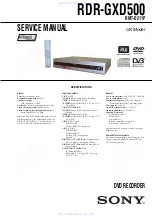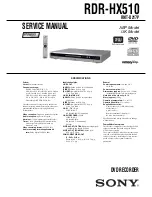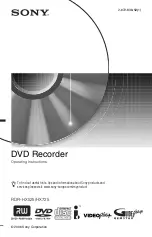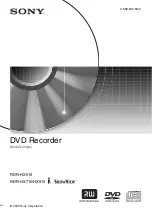
2
TABLE OF CONTENTS
1. SERVICE NOTE
................................................................ 3
2. GENERAL
Index to Parts and Controls ..................................................... 4
3. DISASSEMBLY
3-1. Upper Lid Block Assy ......................................................... 5
3-2. F-SW Board, P-SW Board .................................................. 6
3-3. Main Board ......................................................................... 6
3-4. PC Board ............................................................................. 7
4. TEST MODE
....................................................................... 8
5. DIAGRAMS
5-1. IC Pin Description ............................................................. 11
5-2. Block Diagram .................................................................. 13
5-3. Printed Wiring Board – Main Section – ............................ 15
5-4. Printed Wiring Board – F-SW Section – ........................... 16
5-5. Printed Wiring Board – P-SW, PC Section – .................... 17
5-6. Schematic Diagram – Main Section (1/2) – ...................... 18
5-7. Schematic Diagram – Main Section (2/2) – ...................... 19
5-8. IC Block Diagrams ............................................................ 20
6. EXPLODED VIEWS
6-1. Case Section ...................................................................... 21
6-2. Main Board Section .......................................................... 22
7. ELECTRICAL PARTS LIST
........................................ 23
Notes on Chip Component Replacement
•
Never reuse a disconnected chip component.
•
Notice that the minus side of a tantalum capacitor may be dam-
aged by heat.
ICD-P17
•
UNLEADED SOLDER
Boards requiring use of unleaded solder are printed with the lead-
free mark (LF) indicating the solder contains no lead.
(Caution: Some printed circuit boards may not come printed with
the lead free mark due to their particular size.)
: LEAD FREE MARK
Unleaded solder has the following characteristics.
• Unleaded solder melts at a temperature about 40°C higher than
ordinary solder.
Ordinary soldering irons can be used but the iron tip has to be
applied to the solder joint for a slightly longer time.
Soldering irons using a temperature regulator should be set to
about 350°C.
Caution: The printed pattern (copper foil) may peel away if
the heated tip is applied for too long, so be careful!
• Strong viscosity
Unleaded solder is more viscous (sticky, less prone to flow)
than ordinary solder so use caution not to let solder bridges
occur such as on IC pins, etc.
• Usable with ordinary solder
It is best to use only unleaded solder but unleaded solder may
also be added to ordinary solder.



































